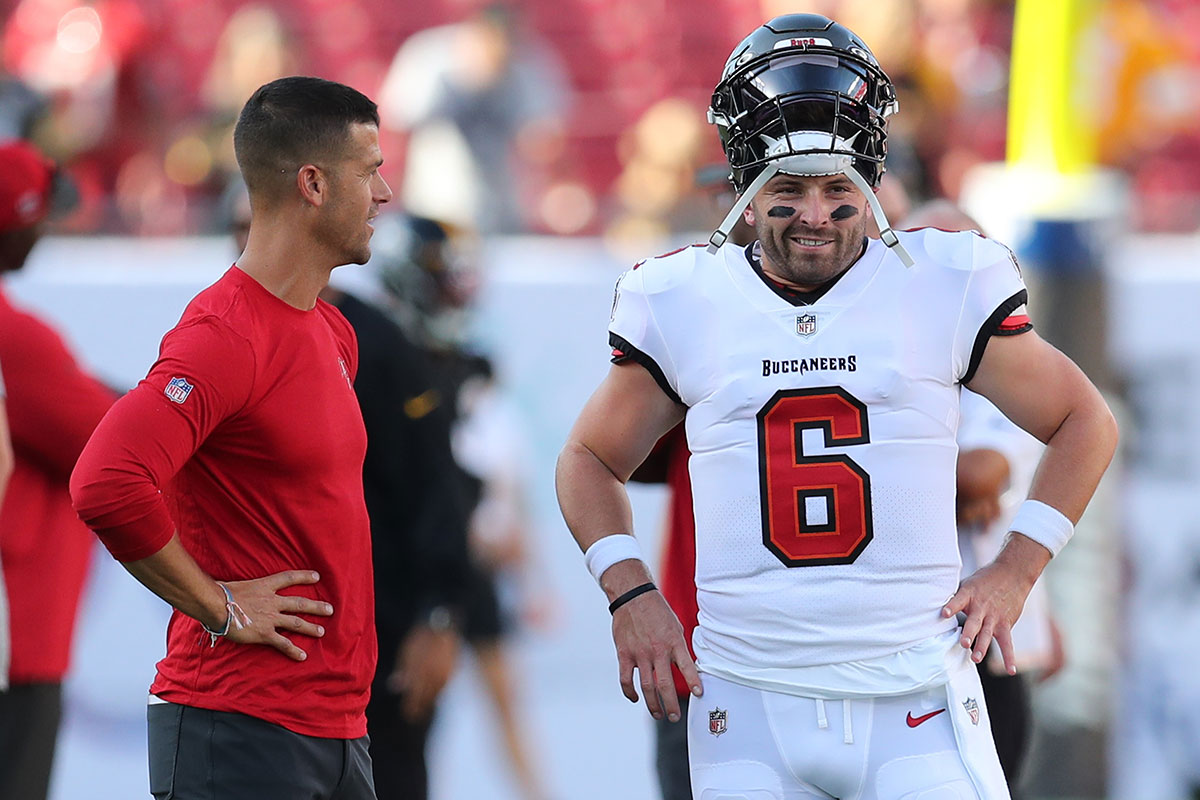The time has finally come. Live Bucs football is back for a new season and fans can rejoice that there is something more to talk about than just off-season narratives.
Or fans can rejoice that they now have more/new information regarding offseason narratives. One such narrative facing the Bucs was that of new offensive coordinator Dave Canales and the offense he would employ after succeeding the much-maligned Byron Leftwich.
The grievances against Leftwich by the time he was unceremoniously dropped from the Bucs coaching staff were long and varied. From not evolving his playbook to running too much on first down – and not enough overall – to his public disdain for analytics, Leftwich left much to be desired according to media and fan alike.
While Canales has said all the right things over the summer leading up to his debut as a play-caller this past Friday night, did the rubber meet the road as they say? I decided to take a look.
Evaluating the Bucs’ Offensive Tendencies
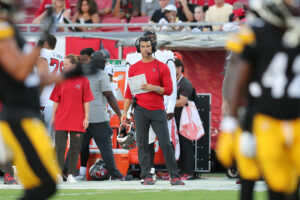
Bucs OC Dave Canales – Photo by: Cliff Welch/PR
Looking at tendencies is a bit more convoluted than just looking at the total number of plays run and assessing the percentages of different variables. Down and distance make a big difference in dictating certain personnel packages as well as the eventual call made.
Canales himself spoke to this very thing during his recent appearance on the “Salty Dogs” podcast. When asked about whether the Bucs would use more 12 personnel (one running back and two tight ends) because Seattle did last year, Canales expounded on how to understand those tendencies with a bit more nuance.
“Yeah, and I think one thing that helps you guys too, as you look at personnel usage and formation types. You go through and you eliminate third downs. Okay? Eliminate third downs. And then eliminate two minutes before the half or two minutes before the end of the game. Then you will reduce a lot of those 11 personnel, 10 personnel, lighter, more receiver formations. And if you look at it in a snapshot of first and second down, you’ll really get a better picture of how people are using and deploying tight ends, or other personnels.
“It will be way more fair. And in terms of run-pass ratio. Because you are going to get into those situations…if you are down two scores or if you are in a two-minute drill, most of it is pass…the way we talk upstairs is say ‘first and second down, no situations.’ So, no specific situations. Just normal ball. And then you will get a real snapshot of what that core system will look like. For ours, for anybody’s.”
Preseason Can Give A Glimpse, But Not The Whole Picture
Now, with Friday’s game against the Steelers being a preseason matchup, there is only so much a person can glean in terms of the way the offense is truly going to operate. Most play-calling on both the offensive and defensive side of the ball is very bland and vanilla because no coordinator wants to get in their bag for a game where the score doesn’t matter with players who are more likely than not to not be on the roster in a month. But at the same time Canales has never called plays above the high school level before so he also has to start working on his craft before the real games start.
It is therefore reasonable to look at some data in terms of what packages and types of plays he called last week to start to get a better idea of what may be in store when the regular season arrives on September 10th.
Bucs’ Personnel Usage
The Bucs had 55 play calls on first or second down Friday. Two of those were during a two-minute drill at the end of the first half and another 11 came during the team’s final drive of the game when time was running out while they were down by 17. According to Canales (and most analytical football minds) those plays need to be removed due to the (pass-heavy) context of those situations. That leaves 42 plays as the sample size from which we can start to glean some tendencies. Starting with personnel it looks like the Bucs might lean heavy on multiple tight-end formations under Canales.
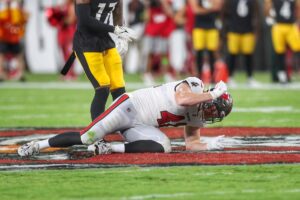
Bucs TE Ko Kieft – Photo By: Cliff Welch/PR
A full 50% of the plays (21) run on first or second down in neutral situations were from 12 personnel, with another two plays utilizing 13 personnel (three tight ends). Meanwhile the Bucs were in 11 personnel (one running back, one tight end with three wide receivers) 45% of the time (19 plays).
This tracks with what Canales was involved in last year in Seattle when the Seahawks used their second and third-string tight ends on a combined 1,008 offensive snaps. Compare that with the Bucs who only used their number two and three tight ends on 621 snaps.
But does that fit the Bucs roster? Seattle had a surplus of depth at the tight end position last year between Noah Fant, Will Dissly and Colby Parkinson. Comparatively their depth at receiver was not as great.
The Seahawks top two receivers could match up well with almost any team in the league, featuring D.K. Metcalf and Tyler Lockett. But behind those two the talent level fell off quite a bit in the form of Marquise Goodwin and D’Wayne Eskridge. So much so that Seattle used a first-round pick in the 2023 NFL Draft to select receiver Jaxson Smith-Njigba.
The Bucs on the other hand are electing to roll into 2023 with 2022 fourth-round pick Cade Otton, who flashed last year but still has a long way to go to be considered an even above-average tight end as their starter. Behind Otton is a wide-open competition between journeyman free agent David Wells, fan-favorite Ko Kieft and rookie fifth-round pick Payne Durham. This isn’t a murderer’s row of above-average talent. But the Bucs have a strong top-three at the receiver position with the Mike Evans, Chris Godwin and Russell Gage, with talented backups like Deven Thompkins and Trey Palmer.
The offense Canales runs has roots in heavy 12 personnel dating back to Kyle Shanahan and his father Mike, who really birthed the outside/wide zone offense. But as those two produced talented coaches who came into their own the offense evolved with different captains who were piloting their respective ships.
The most famous offshoot of that original system is Sean McVay and his more 11 personnel, mid-zone scheme. That is the scheme that Seahawks offensive coordinator Shane Waldron derives from. And it is the system that he taught to Canales. Additionally, Canales has stated before that he wants to tailor the offense to the talent he has. That should mean more 11 personnel, so this bears further watching.
Bucs’ Under Center vs. Shotgun
The Seahawks were in shotgun 36% of the time last year according to NFLeo. Did that same tendency bear out in the Bucs first preseason game? Not really. Of the 42 first- and second-down plays the Bucs ran in neutral situations only seven (17%) came from a gun formation. Most of the night had quarterbacks Baker Mayfield, Kyle Trask and John Wolford running the offense from under center. And this makes sense at it gives the offense the greatest flexibility in terms of run, pass, play-action to keep the opposing defense on their heels.
Bucs’ Run-Pass Ratio
This one is a big pressure point for those who follow the Bucs. This is best described as the run-pass rate in 1st and 10 situations. This is where the offense has the most flexibility to go in either direction. The best offenses in the league choose to pass more in these situations.
#Seahawks end the season with the 5th highest pass rate in neutral situations, even with run heavy game plans to end the season due to injuries at OL, WR, TE and necessity to build cohesion in their run blocking. pic.twitter.com/gfHpDMNud1
— splitflow drive strong curl takes 2 back for 3yrds (@cmikesspinmove) January 10, 2023
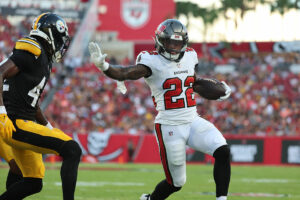
Bucs RB Chase Palmer – Photo by: USA Today
Six of the top eight offenses in expected points added per play last year were in the top 12 in the above metric. And you will notice the Bucs were seventh in pass rate in neutral 1st and 10 situations. So how come Leftwich was still vilified? It’s because the disparity between the effectiveness of his pass and run game was so wide seventh wasn’t good enough. He should have been first by a wide margin to help the offense be more effective.
On Friday the Bucs faced first-and-10 in neutral situations 20 times. They passed just five times. A term I have heard a lot in the past few months in another part of my life certainly would apply to this trend if it were to continue into the regular season. That term is “less than ideal.” Here is to hoping this was a function of getting certain guys specific reps and is not a sign of things to come.
Play Action
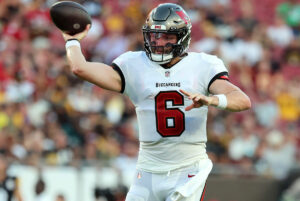
Bucs QB Baker Mayfield – Photo by: USA Today
Oooh buddy. This is the most exciting part of the scheme-change. It is a proven fact that passing games work much more effectively from play-action than from traditional dropbacks. Of the 25 quarterbacks who qualified last year, only two had a negative yards per attempt difference from play-action to non-play-action and only seven had Pro Football Focus grades that were better in non-play action settings.
And yet the Bucs 2022 starting quarterback Tom Brady, who led all quarterbacks in pass attempts ranked 2nd-to-last in play action attempts. Now, some might argue it is because the Bucs’ run game was horrid, and therefore play-action wouldn’t work because opposing defenses wouldn’t respect the run. But that theory doesn’t really hold water as Brady ranked third in PFF grade on play-action throws.
Well, I have some good news for those of you who are hoping for a play-action rate north of the 16.2% Brady ran last year. Twelve of the 21 passes Canales called in neutral first and second down situations on Friday were of the play-action variety. That’s a staggering 57%! Last year the quarterback with the highest play-action rate for was Tua Tagovailoa of the Miami Dolphins. He clocked in at 43%.
Conclusions?
Can we draw any conclusions from the Bucs first preseason game of the 2023 season? Probably not much. But we don’t have to throw all of it out, either.
Most of what we saw tracks with the hypotheses we had about Dave Canales. There was a lot of multiple tight end packages. Though it might not be the most efficient use of resources for the Bucs. They ran more on first down than last year, which does not track with the offense Canales helped run last year. But when the Bucs did pass they made sure it was in a way that is most advantageous to them. Well, two out of three ain’t bad.
Josh Queipo joined the Pewter Report team in 2022, specializing in salary cap analysis and film study. In addition to his official role with the website and podcast, he has an unofficial role as the Pewter Report team’s beaming light of positivity and jokes. A staunch proponent of the forward pass, he is a father to two amazing children and loves sushi, brisket, steak and bacon, though the order changes depending on the day. He graduated from the University of South Florida in 2008 with a degree in finance.

